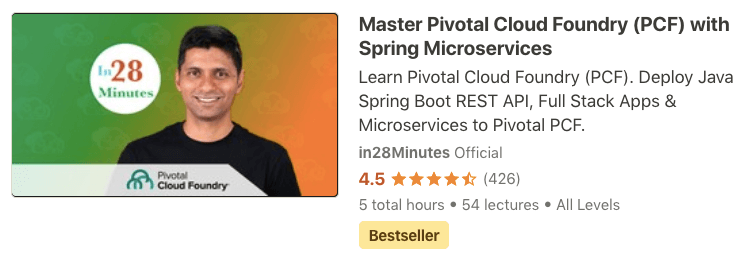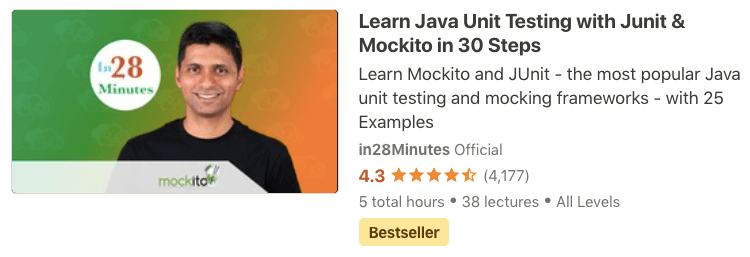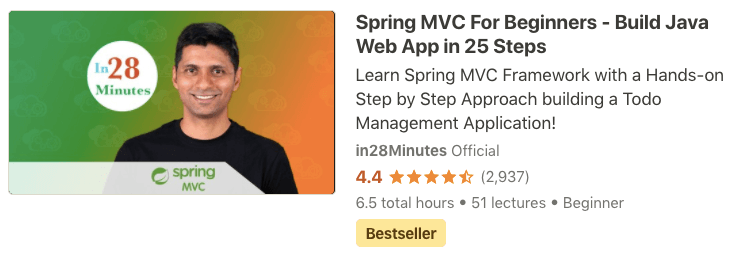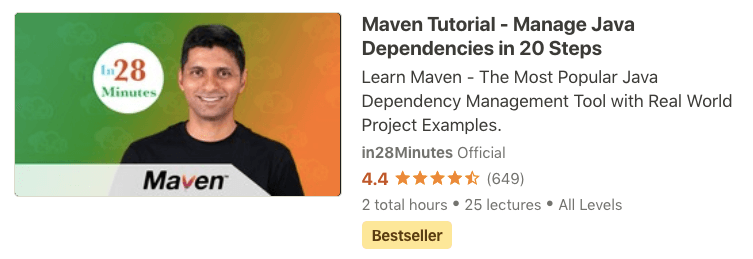We started in28Minutes to create awesome learning experiences for Cloud, Java, Spring Boot & Full Stack with Hands-on Courses using Real World Projects.
We use Problem-Solution based Step-By-Step Hands-on Approach With Practical, Real World Application Examples.
We have 25+ Courses providing amazing learning experiences in Java Programming, Java Frameworks (Spring, Spring Boot, Spring MVC, Struts, Hibernate), Cloud (AWS, PCF, GCP and Azure) and Full Stack ( React, Angular ). We also have courses teaching the amazing world of Python Programming and Automation Testing with Selenium Web Driver.
Today we have 300,000 Learners pursuing our courses on various platforms including Udemy, Safari Online and Packt.
Best Courses are interactive and fun.
Foundations for building high quality applications are best laid down while learning.
We use 80-20 Rule. We discuss 20% things used 80% of time in depth. We touch upon other things briefly equipping you with enough knowledge to find out more on your own.
We use a Problem Solution based Step by Step Hands-on Learning Approach.
Learn Docker containerizing Java Spring Boot Apps - REST API, Full Stack and Microservices with Docker Compose
Architectures are moving towards Microservices and Cloud. Docker makes it easy to containerize your applications and make them cloud-ready.
Docker is the No 1 Tool to Containerize your Java Spring Boot Applications. Learning Docker would help you streamline your deployment processes and experiment easily with new frameworks and tools.
In this hands-on course, we will containerize - create docker images and create containers - a variety of Spring Boot Applications:
-
REST APIs - Hello World and Todo - Jar
-
Todo Web Application War
-
Full Stack Application with React and Spring Boot
-
CCS and CES Microservices
-
Eureka Naming Server and Zuul API Gateway
This course would be a perfect first step as an introduction to Docker.
You will be using containerizing a variety of projects created with React (Frontend Framework), Spring Boot (REST API Framework), Spring (Dependency Management), Spring Security (Authentication and Authorization - Basic and JWT), BootStrap (Styling Pages), Maven (dependencies management), Node (npm), Visual Studio Code (TypeScript IDE), Eclipse (Java IDE) and Tomcat Embedded Web Server. We will help you set up each one of these.

Pivotal Cloud Foundry (PCF) provides a great cloud native platform to deploy Spring Boot Applications.
Spring Boot is the No 1 Java Framework to develop REST API and Microservices.
In this course, we deploy a variety of Spring Boot Applications to the Cloud:
-
REST APIs - Hello World and Todo - Jar
-
Todo Web Application War
-
Full Stack Application with React and Spring Boot
-
CCS and CES Microservices
-
Route Services
This course would be a perfect first step as an introduction to PCF and the Cloud.
You will be using deploying a variety of projects to Pivotal Cloud Foundry (PCF) . These projects are created with React (Frontend Framework), Spring Boot (REST API Framework), Spring (Dependency Management), Spring Security (Authentication and Authorization - Basic and JWT), BootStrap (Styling Pages), Maven (dependencies management), Node (npm), Visual Studio Code (TypeScript IDE), Eclipse (Java IDE) and Tomcat Embedded Web Server. We will help you set up each one of these.
How about learning AWS (Amazon Web Services) deploying Spring Applications to Cloud using Elastic Beanstalk?
Spring Boot is the No 1 Java Framework to develop REST API and Microservices. AWS (Amazon Web Services) is the No 1 Cloud Service Provider today.
In this course, we deploy a variety of Spring Boot Applications to the Cloud:
-
REST APIs - Hello World and Todo - Jar
-
Todo Web Application War
-
Full Stack Application with React and Spring Boot
-
Single Container with Java REST API
-
Multi Container with Todo REST API talking to MySQL
This course would be a perfect first step as an introduction to AWS and the Cloud, especially for Java Developers.
You will learn about automating deployments with Elastic Beanstalk CLI and creating a continuous delivery pipeline with AWS Code Pipeline. You will learn how to Auto Scale applications based on load as well as deploy multiple instances behind a load balancer using Elastic Beanstalk.
You will be using a number of AWS Services - EC2, S3, AWS CodePipeLine, AWS CodeBuild, SQS, IAM, CloudWatch.
You will be using deploying a variety of projects to Amazon Web Services (AWS). These projects are created with React (Frontend Framework), Spring Boot (REST API Framework), Spring (Dependency Management), Spring Security (Authentication and Authorization - Basic and JWT), BootStrap (Styling Pages), Maven (dependencies management), Node (npm), Visual Studio Code (TypeScript IDE), Eclipse (Java IDE) and Tomcat Embedded Web Server. We will help you set up each one of these.
AWS (Amazon Web Services) is the No 1 Cloud Service Provider today. Spring Boot is the No 1 Java Framework to develop REST API and Microservices.
How about learning AWS by deploying Spring Boot Docker Containers to Amazon Web Services using Elastic Container Service - ECS and AWS Fargate?
This course would be a perfect first step as an introduction to Amazon Web Services - AWS and the Cloud.
In this course, we deploy a variety of Java Spring Boot Microservices to Amazon Web Services using AWS Fargate and ECS - Elastic Container Service.
You will learn the basics of implementing Container Orchestration with ECS (Elastic Container Service) - Cluster, Task Definitions, Tasks, Containers and Services. You will learn about the two launch types of ECS - EC2 and AWS Fargate. In this course, we would focus extensively on AWS Fargate to simplify your Container Orchestration. You will learn to deploy multiple containers in the same ECS task.
You will learn to Build Container Images for your Java Spring Boot Microservice Projects.
You will implement the following features for your Microservices
-
Centralized Configuration Management with AWS Parameter Store
-
Distributed Tracing with AWS X Ray
-
Auto Scaling and Load Balancing with ECS, Elastic Load Balancers and Target Groups
-
Service Mesh using AWS App Mesh. You will learn the basics of AWS App Mesh - Mesh, Virtual Nodes and Virtual Services. You will learn to perform Canary Deployments using AWS AppMesh.
-
Service Discovery with Route 53 Hosted Zones and DNS.
-
Continuous Integration and Continuous Deployment with AWS Code Pipeline
You will learn to debug problems with deploying containers using Service events and AWS CloudWatch logs.
You will learn about automating deployments and creating a continuous delivery pipeline with AWS Code Pipeline. You will learn how to Auto Scale applications based on load as well as deploy multiple instances behind a load balancer using AWS ECS Fargate.
You will be using a number of AWS Services - ECS - Elastic Container Services, AWS Fargate, EC2 - Elastic Compute Cloud, S3, AWS CodePipeLine, AWS CodeBuild, IAM, CloudWatch, ELB, Target Groups, X Ray, AWS Parameter Store, AWS App Mesh and Route 53.
You will be using deploying a variety of projects to Amazon Web Services (AWS). These projects are created with Spring Boot (REST API Framework), Spring (Dependency Management), Maven (dependencies management), Eclipse (Java IDE) and Tomcat Embedded Web Server. We will help you set up each one of these.
Developing your first full stack web application with React and Spring Boot is fun.
In this Course, you will Learn the basics of full stack web development developing a Basic Todo Management Application using React, Spring Boot and Spring Security Frameworks. You will build the Todo Management Application step by step - in more than 100 steps.
You will be using React (Frontend Framework), Modern JavaScript , Create React App(To create React projects), Spring Boot (REST API Framework), Spring (Dependency Management), Spring Security (Authentication and Authorization - Basic and JWT), BootStrap (Styling Pages), Maven (dependencies management), Node (npm), Visual Studio Code (JavaScript IDE), Eclipse (Java IDE) and Tomcat Embedded Web Server.
We will help you set up each one of these.
React is a view framework providing great deal of flexibility in integrating with a wide range of frameworks to provide a wide range of features. Spring Boot is an awesome framework to build RESTful API and Microservices. Lets combine these frameworks and create an awesome full stack web application.
Developing your first full stack web application with Angular and Spring Boot is fun.
In this Course, you will Learn the basics of full stack web development developing a Basic Todo Management Application using Angular, Spring Boot and Spring Security Frameworks. You will build the Todo Management Application step by step - in more than 100 steps.
You will be using Angular (Frontend Framework), TypeScript Basics, Angular CLI(To create Angular projects), Spring Boot (REST API Framework), Spring (Dependency Management), Spring Security (Authentication and Authorization - Basic and JWT), BootStrap (Styling Pages), Maven (dependencies management), Node (npm), Visual Studio Code (TypeScript IDE), Eclipse (Java IDE) and Tomcat Embedded Web Server.
We will help you set up each one of these.
Angular is a complete front end framework with a wide range of features. Spring Boot is an awesome framework to build RESTful API and Microservices. Lets combine these frameworks and create an awesome full stack web application.
How to become a Software Architect? This is the number one question that I’m asked when talking to Programmers and Senior Developers. And this course provides an answer to that question.
In this course, You will learn how to start your journey towards becoming a Software Architect. You will understand what Architecture is all about and what your goal as an Architect should be. You will understand the thought process of successful Software Architects.
You will learn about the fundamental pillars of Sofware Architecture - Technology Skill, Domain Knowledge and Soft Skills. You will understand the importance of Enterprise and Application Standards with examples of REST API and Microservice Standards. You will learn about the importance of having Good Governance as a Software Architecture Team. You will learn how to make your teams productive.
In this course, we will NOT discuss about specific architecture patterns. The objective to get your mindset right.
Developing RESTful web services and REST API is fun. The combination of Java, Spring Boot, Spring Web MVC, Spring Web Services and JPA makes it even more fun. And its even more fun to create Microservices.
There are two parts to this course - RESTful web services and Microservices
Architectures are moving towards microservices. RESTful web services are the first step to developing great microservices. Java and Spring Boot, in combination with Spring Web MVC (also called Spring REST) makes it easy to develop RESTful web services.
In the first part of the course, you will learn the basics of RESTful web services developing resources for a social media application. You will learn to implement these resources with multiple features - versioning, exception handling, documentation (Swagger), basic authentication (Spring Security), filtering and HATEOAS. You will learn the best practices in designing RESTful web services.
In this part of the course, you will be using Spring (Dependency Management), Spring MVC (or Spring REST), Spring Boot, Spring Security (Authentication and Authorization), Spring Boot Actuator (Monitoring), Swagger (Documentation), Maven (dependencies management), Eclipse (IDE), Postman (REST Services Client) and Tomcat Embedded Web Server. We will help you set up each one of these.
In the second part of the course, you will learn the basics of Microservices. You will understand how to implement microservices using Spring Cloud.
In this part of the course, you will learn to establish communication between microservices, enable load balancing, scaling up and down of microservices. You will also learn to centralize configuration of microservices with Spring Cloud Config Server. You will implement Eureka Naming Server and Distributed tracing with Spring Cloud Sleuth and Zipkin. You will create fault toleranct microservices with Zipkin.
Hibernate is the most popular implementation of JPA. It was the most popular ORM framework option before JPA emerged and it provides additional features on top of JPA. We will use Hibernate as the JPA implementation in this course.
The Java Persistence API provides Java developers with an api for mapping java objects to relational data. In this course, you will learn about the Hibernate, JPA API, JPQL (Java Persistence query language), Java Persistence Criteria API and how you can perform ORM (Object Relational Mapping) with JPA and Hibernate.
During this course
-
You will learn the basics of JPA and Hibernate - Entities, Relationships, Inheritance Mappings and Annotations
-
You will understand approaches to querying data using JPA and Hibernate - JPQL, Criteria API and Native Queries
-
You will understand JPA and Hibernate Relationships in depth - One to One, Many to One and Many to Many
-
You will use a variety of Spring Boot Starters - Spring Boot Starter Web, Starter Data Jpa, Starter Test
-
You will learn the basic of performance tuning your JPA application with Hibernate - Solve N+1 Queries Issue.
-
You will learn the basics of caching - First Level Cache and Second Level Cache with EhCache
-
You will understand the basics of Spring Data JPA and Spring Data REST
In this course, you will learn the features of Spring, Spring Boot and Spring Modules - JDBC, AOP, Data JPA with hands-on step by step approach.
You will get introduced to Spring Boot, Unit Testing with JUnit and Mockito, talking to the database with Spring JDBC and JPA, Maven (dependencies management), Eclipse (IDE) and Tomcat Embedded Web Server. We will help you set up each one of these.
You will learn about Spring step by step - in more than 100 steps. This course would be a perfect first step as an introduction to Spring.
You will learn about
-
Basics of Spring Framework - Dependency Injection, IOC Container, Application Context and Bean Factory.
-
Spring Annotations - @Autowired, @Component, @Service, @Repository, @Configuration, @Primary....
-
Spring MVC in depth - DispatcherServlet , Model, Controllers and ViewResolver
-
Spring Boot Starters - Spring Boot Starter Web, Starter Data Jpa, Starter Test
-
Basics of Spring Boot, Spring AOP, Spring JDBC and JPA
-
Basics of Eclipse, Maven, JUnit and Mockito
-
Basic concept of a Web application step by step using JSP Servlets and Spring MVC
-
Unit testing with JUnit and Mockito using XML and Java Spring Application Contexts
Developing SOAP and RESTful web services is fun. The combination of Spring Boot, Spring Web MVC, Spring Web Services and JPA makes it even more fun.
Architectures are moving towards microservices. RESTful web services are the first step to developing great microservices. Spring Boot, in combination with Spring Web MVC (also called Spring REST) makes it easy to develop RESTful web services.
There are two parts to this course - RESTful web services and SOAP Web Services.
In the first part of the course, you will learn the basics of RESTful web services developing resources for a social media application. You will learn to implement these resources with multiple features - versioning, exception handling, documentation (Swagger), basic authentication (Spring Security), filtering and HATEOAS. You will learn the best practices in designing RESTful web services.
You will be using Spring (Dependency Management), Spring MVC (or Spring REST), Spring Boot, Spring Security (Authentication and Authorization), Spring Boot Actuator (Monitoring), Swagger (Documentation), Maven (dependencies management), Eclipse (IDE), Postman (REST Services Client) and Tomcat Embedded Web Server. We will help you set up each one of these.
While the use of SOAP Web Services is on the way down, there are still considerable number of web services using this approach.
In the second part of the course, you will learn the basics of implementing SOAP Web Services developing a few web services for a course management application. You will learn to use a Contract first approach - defining XSD (XML Schema Definition) for your requests and responses. You will learn about WSDL (SOAP Header, SOAP Body and SOAP Fault), XSD (XML Schema Definition) and JAXB (Java API for XML Binding). You will implementing three SOAP web services with exception handling and basic security (with WS Security).
In this part of the course, you will be using Spring (Dependency Management), Spring Web Services , Spring Boot, Spring Security (Authentication and Authorization), Maven (dependencies management), Eclipse (IDE), Wizdler (SOAP Services Chrome Plugin) and Tomcat Embedded Web Server. We will help you set up each one of these.
Spring Boot has a lot of magic going for it. Developing REST Services with Spring Boot is cool and fun. Spring Boot makes it easy to create stand-alone, production-grade Spring based Applications that you can “just run”. Most Spring Boot applications need very little Spring configuration.
This course is now updated with new sections. Updated with Spring Boot 2 and Spring 5.
In this course, you will learn the features of Spring Boot and Spring Boot Starter Projects with hands-on step by step approach developing:
-
Basic Todo Management Java Application using Spring Boot with Login and Logout functionalities
-
Basic REST Service to manage Survey Questionnaire
You will get introduced to REST Services, Spring Security (Authentication and Authorization), Maven (dependencies management), Eclipse (IDE) and Tomcat Embedded Web Server. We will help you set up each one of these.
You will learn about Spring Boot step by step - in more than 100 steps. This course would be a perfect first step as an introduction to Spring Boot.



























